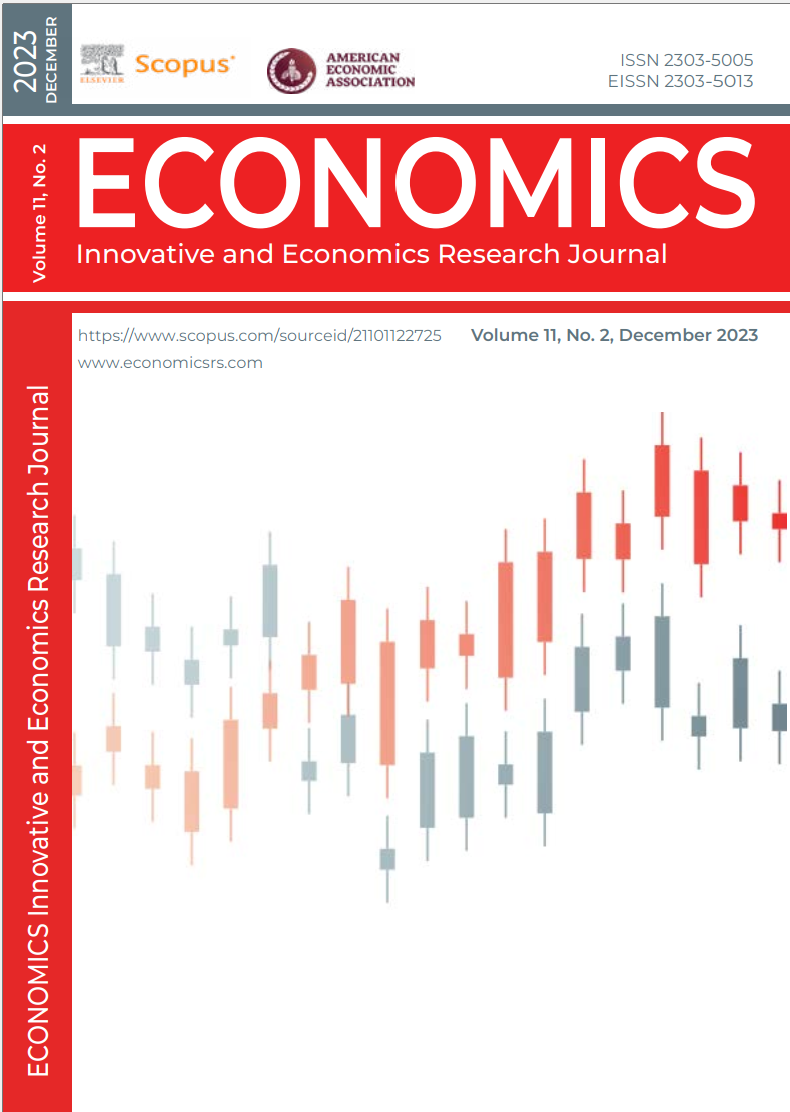IMPACT OF TRADE OPENNESS, HUMAN CAPITAL THROUGH INNOVATIONS ON ECONOMIC GROWTH: CASE OF THE BALKAN COUNTRIES
DOI:
https://doi.org/10.2478/eoik-2023-0047Ključne reči:
trade openness, human capital, innovations, economic growth, GDPApstrakt
The importance of trade openness and human capital for the economic growth of countries is the subject of many studies today. The role of innovations and the innovativeness of economies in modern economic development is extremely important. With greater accumulation of human capital, knowledge, skills and innovation are accumulated. All these variables are crucial for achieving higher economic growth. Special attention in the studies of relevant authors is directed towards researching this relationship on the example of small open economies, as well as developing countries. The purpose of this paper is to examine the relationship between trade openness and human capital as explanatory variables and GDP as a dependent variable in a sample of eight Balkan countries. The goal of the research is to quantify the relationship between two independent variables and GDP as a dependent variable. The period in which we observe this relationship covers the period from 2000 to 2019. Achieving the research objective is done on the basis of a panel model with fixed and random effects. The results of the panel research testify to the existence of a positive relationship between trade openness and human capital as independent variables and GDP as a dependent variable. Calculated coefficients with independent variables were obtained with a high level of statistical significance. The conclusion of the research implies that there is a positive impact of trade openness and human capital on GDP.
Reference
Abendin, S., & Duan, P. (2021). International trade and economic growth in Africa: The role of the digital economy. Cogent Economics & Finance, 9(1). https://doi.org/10.1080/23322039.2021.1911767
Alesina, A., Spolaore, E., & Wacziarg, R. (2000). Economic Integration and Political Disintegration. American Economic Review, 90(5), 1276-1296. https://doi.org/10.1257/aer.90.5.1276
Barro, R. J., & Sala-i-Martin, X. (1997). Technological Diffusion, Convergence, and Growth. Journal of Economic Growth, 2(1), 1-26. https://www.jstor.org/stable/40215930
Bojat, M., Kovačević, S., & Kurušić, D. (2021). Interdependence of foreign trade and economic growth of Serbia. Proceedings of the Faculty of Economics in East Sarajevo, 23, 21-42. https://doi.org/10.7251/ZREFIS2123021B
Dauti, B., & Elezi, S. (2022). Economic growth in the Central East European Union and the Western Balkan countries in the course of Stability and Growth Pact and COVID-19. Zbornik radova Ekonomskog fakulteta u Rijeci/Proceedings of Rijeka Faculty of Economics, 40(1), 29-61. https://doi.org/10.18045/zbefri.2022.1.29
Edwards, S. (1997). Openness, Productivity and Growth: What Do We Really Know? NBER Working Paper Series, Working Paper No, 5978. https://www.nber.org/system/files/working_papers/w5978/w5978.pdf
Fatima, S., Chen, B., Ramzan, M., & Abbas, Q. (n.d.). The Nexus Between Trade Openness and GDP Growth: Analyzing the Role of Human Capital Accumulation. SAGE Open, 10(4). https://doi.org/10.1177/2158244020967377
Gries, T., & Redlin, M. (2012). Trade Openness and Economic Growth: A Panel Causality Analysis. Working Paper CIE 52. http://groups.uni-paderborn.de/wp-wiwi/RePEc/pdf/ciepap/WP52.pdf
Groningen Growth and Development Centre. (2023). Penn World Table version 10.01. DataverseNL. https://doi.org/10.34894/QT5BCC
Grossman, G. M., & Helpman, E. (1991). Trade, knowledge spillovers, and growth. European Economic Review, 35(2-3), 517-526. https://doi.org/10.1016/0014-2921(91)90153-A
Hausman, J. (1978). Specification Tests in Econometrics. Econometrica, 64(6), 1251-1271. https://doi.org/10.2307/1913827
Huchet-Bourdon, M., Le Mouël, C., & Vijil, M. (2018). The relationship between trade openness and economic growth: Some new insights on the openness measurement issue. The World Economy, 41(1), 59-76. https://doi.org/10.1111/twec.12586
International Monetary Fund. (2022). World Economic Outlook, October 2022. Washington: International Monetary Fund. www.imf.org/en/Publications/WEO/weo-database/2022/October
Iyke, B. N. (2017). Does Trade Openness Matter for Economic Growth in the CEE Countries? Review of Economic Perspectives, 17(1), 3-24. https://doi.org/10.1515/revecp-2017-0001
Krajišnik, M., Gojković, B., Josipović, S., & Popović, S. (2020). Impact of Exports on Economic Growth in Bosnia and Herzegovina. Acta Economica, 18(32), 59-84. https://doi.org/10.7251/ACE2032059K
Krueger, A. O. (1997). Trade Policy and Economic Development: How We Learn. NBER Working Paper Series, WP 5896. https://www.nber.org/system/files/working_papers/w5896/w5896.pdf
Krugman, P. (1985). A ‘Technology Gap’ Model of International Trade. In K. Jungenfelt, & S. D. Hague, Structural Adjustment in Developed Open Countries (35-50). New York: St. Martin`s Press.
Luqman, M., & Soytas, U. (2023). Asymmetric role of human capital and trade liberalization in the economic growth of Pakistan: Fresh evidence from the nonlinear analysis. The Journal of International Trade & Economic Development, 32(3), 473-495. https://doi.org/10.1080/09638199.2022.2105386
Mankiw, G. N., Romer, D., & Weil, D. N. (1992). A Contribution to the Empirics of Economic Growth. The Quarterly Journal of Economics, 107(2), 407-437. https://doi.org/10.2307/2118477
Mendes de Oliveira, M., Santos, M. C., & Kiker, B. F. (2000). The role of human capital and technological change in overeducation. Economics of Education Review, 19(2), 199-206. https://doi.org/10.1016/S0272-7757(99)00020-5
Philippe, A., & Howitt, P. (1992). A Model of Growth Through Creative Destruction. Econometrica, 60(2), 323-351. https://doi.org/10.2307/2951599
Popović, G., Erić, O., & Popović, S. (2019). Foreign trade liberalization and economic growth: The case of the Republic of Srpska. ECONOMICS - Innovative and Economics Research Journal, 7(2), 99-108. https://doi.org/10.2478/eoik-2019-0020
Popović, G., Erić, O., & Stanić, S. (2020). Trade Openness, Institutions and Economic Growth of the Western Balkans Countries. Montenegrin Journal of Economics, 16(3), 173-184. https://doi.org/10.14254/1800-5845/2020.16-3.14
Romer, P. M. (1990). Endogenous Technological Change. Journal of Political Economy, 98(5), 71-102. https://doi.org/10.1086/261725
Winters, A. L. (2004). Trade Liberalisation and Economic Performance: An Overview. The Economic Journal, 114(493), F4-F21. https://doi.org/10.1111/j.0013-0133.2004.00185.x
Winters, A. L., McCulloch, N., & McKay, A. (2004). Trade Liberalization and Poverty: The Evidence So Far.Journal of Economic Literature, XLII, 72-115. https://doi.org/10.1257/002205104773558056
World Bank. (2022). World development indicators. www.datacatalog.worldbank.org/dataset/world-development-indicators
Young, A. (1991). Learning by doing and the dynamic effects of international trade. The Quarterly Journal of Economics, 106(2), 369-405. https://doi.org/10.2307/2937942
##submission.downloads##
Objavljeno
Kako citirati
Broj časopisa
Sekcija
Licenca
Sva prava zadržana (c) 2023 ECONOMICS - INNOVATIVE AND ECONOMICS RESEARCH JOURNAL

Ovaj rad je pod Creative Commons Aуторство-Nekomercijalno-Bez prerade 4.0 Internacionalna licenca.





